Modern art in an 800-year-old setting, Salisbury
Salisbury Cathedral is known for many things – the tallest church spire in the UK, the best surviving copy of the Magna Carta, the oldest working clock in the world – but not, perhaps, its art. Yet when I visited with my partner in July, the modern art on display in these medieval surroundings was breathtaking.
As well as its permanent collection, which includes sculptures by Barbara Hepworth and Elisabeth Frink, there is a year-long temporary exhibition (until 18 April 2021). The show, Spirit and Endeavour, celebrates 800 years of the cathedral (it was resited from Old Sarum, two miles away). We spotted an Antony Gormley figure high above the choir, a Grayson Perry tapestry in the nave and a Mark Wallinger video projected on to a chapel wall.
Outside, Henry Moore’s Large Reclining Figure lords it over an interesting selection of other sculptures. Feeling inspired, we strolled over the water meadows to the spot where Constable painted many views of the cathedral. But instead of getting our sketchbooks out, we carried on to the Old Mill for a waterside pint – art appreciation is thirsty work.
Rachel Dixon
Spectacular cycling, northern Spain
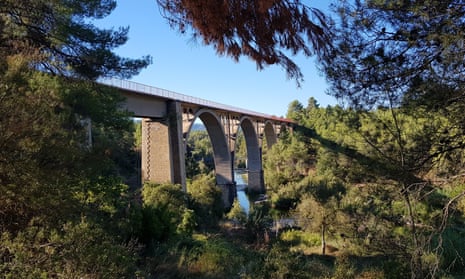
I spent January and February on a Spanish road trip, little knowing this would be the extent of my international travels for 2020. I went out on a high, swapping car for bicycle to ride the Via Verde Val de Zafan, a disused railway line that is now one of Spain’s most spectacular cycle routes.
At 105 miles, this is the second-longest of Spain’s Green Ways, running imperceptibly downhill from the highlands of Aragon and Catalonia to the mighty Ebro River in the Roman city of Tortosa. It takes in two lesser-known natural parks and an amazing sensation of wilderness. The Catalan section of Els Ports especially, with its limestone cliffs and waterfalls, provides a backdrop reminiscent of the American West.
But refreshment is never too far away and some of the stations have been turned into (very welcome) bars and cafes, while pools and rivers offer impromptu swims when things get hot and sweaty. Throw in the thrills of pedalling through pitch-black tunnels, over soaring viaducts and past medieval hermitas, and this makes an awe-inspiring ride.
Lois Pryce, author of Revolutionary Road
A fishing odyssey of southern England
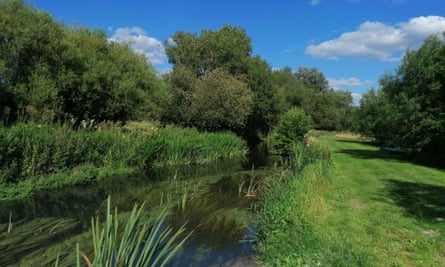
Wednesday 13 May was liberation day for me: it was when anglers were allowed to pick up their rods and head to the water’s edge again, some six weeks after the trout season normally opens. We fishermen are more fortunate than most, having been allowed to pursue our sport ever since. So, spurred by my lockdown discovery of NW Fishing Secrets on YouTube – about wild fishing and camping in Washington state – I resolved this year to fish as many new places as possible.
I started at Bewl Water, a vast reservoir on the Kent and East Sussex border, because I wanted to be afloat on a limitless horizon after being locked in. People travel from as far as Belgium to fish this lake and, on an unseasonably hot day, it felt like being in another country. The trout must have been abroad as well, because I left empty-handed.
In June, I headed to Berkshire and the river Lambourn. As BBC cricket commentator Howard Marshall wrote in his 1967 book Reflections on a River, “Simple things – so many of them – make up the angler’s true delight. And all of them may be found on the banks of the little River Lambourn.”
On the Avon in Wiltshire in July, I chatted to a poacher turned river keeper, and spotted a hedgehog, my first sighting since childhood. But the best discovery came in Dorset in September, when I was on my way to fish the river Frome in Wrackleford. Stopping to watch workers rethatch a cottage in Martinstown, I noticed a hut with a vending machine and what looked like a large fridge. It turned out to be pumping organic milk from Eweleaze farm up the hill into bottles you bought from another machine. Next to it was a vending machine selling the farm’s eggs, cheese and butter. What an udderly brilliant rural innovation. And perfect for a fisherman who all too often goes home empty-handed.
Andy Pietrasik
Welcome to the house of fun, Dorset

In this strangest of years, one weekend stands out as a sunny memory – a 40th birthday do in an extraordinary house in Dorset. The Houseboat in Hamworthy, near Poole, has won RIBA awards for its design. Resembling two upturned hulls leaning together, it’s a modern wood-and-glass affair, flooded with light from floor-to-ceiling windows overlooking Poole Harbour. It may just have been the post-lockdown excitement (luck was on our side: we were a party of nine and later that week the rule of six was announced), but the open-plan, multi-level space and cool retro decor screamed fun.
There is not a huge amount of outdoor space at the Houseboat (though the sunset-facing terrace is great for alfresco dining), but you can walk straight out on to Ham Common nature reserve, and there are steps leading to a private beach, and coastal footpaths nearby. I’d like to say we explored the Purbecks and more of the Jurassic coast – but we mostly wandered locally, hung out at the house and enjoyed precious time with friends in a particularly special setting.
• Sleeps 10in three doubles and a four-bed bunk room, from £330 a night (three-night min), thehouseboat-poole.co.uk
Jane Dunford
A children’s adventure story on the Isles of Scilly
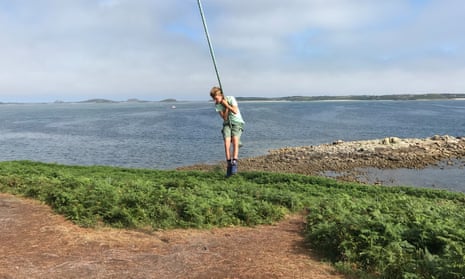
You could hardly call the Scillies a discovery – there are families who have been holidaying there for generations. They book the same cottage year after year, have a favourite beach and know the best crabbing spots and coves where you can swim ith seals. But beyond Hugh Town on the main island of St Mary’s, it’s very easy to find yourself alone in an incredibly beautiful spot – and feel like you’re the first person to have stumbled across it.
On our final day there my 10-year-old son and I headed to the northern tip of St Mary’s in search of “the swing” – it’s just a foam buoy on a grubby rope but it must have one of the best views of any swing in the country, set on the edge of woodland overlooking the Atlantic. It would have been worth the trip just to fly through the air looking out over the scalloped, rocky coastline and blue-green sea, but this is also the site of Innisidgen, an amazingly well-preserved prehistoric burial chamber.
A path leads from there to a white-sand bay, where we dashed into the freezing sea, not caring that we’d have to make the journey home with salty skin and wet hair.
A swing, a grave, an empty beach … we felt like we were in a children’s adventure story. The only things missing were jam sandwiches and ginger beer. But after months of lockdown in London, being able to see the horizon and breathe clean sea air was sustenance enough.
Isabel Choat
Somerset’s new pilgrim route
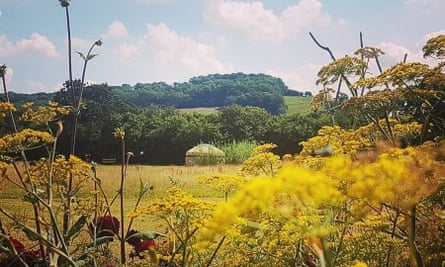
When the first lockdown ended, I was wary of wandering too far, so started from my doorstep on a solo hike along the Glastonbury Water Way. And I’m glad I did. This 55-mile route, launched earlier this year by the British Pilgrimage Trust, runs from Bath (where I live) to Glastonbury via Somerset’s rivers, pools, sacred springs and holy wells. A proper refresher. All too literally, in fact, as I picked a very wet weekend.
But the weather gods were forgiven when I arrived at the Lorax Patch (pitches from £8), a small and wonderfully almost-wild campsite on the outskirts of Wells. It was still drizzling as I erected my teeny tent on the generous pitch (one of only four). But by the time I’d used my private, composting loo, managed to light the logs in my firepit and sat down at my picnic table, the rain had stopped and the sun was setting with red-gold histrionics over the Somerset Levels. A heavyweight microadventure.
Sarah Baxter
Old marsh island, Suffolk
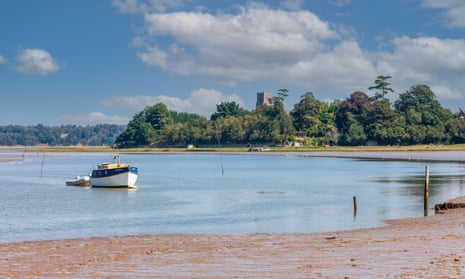
In July, searching for new walks for my podcast, I found myself at Iken, near the Suffolk coast. It’s an extraordinary place: a tiny church on a promontory surrounded by tidal creeks, salt marsh, dense reedbeds and gleaming mudflats, where all you can hear is the cry of shorebirds. And it’s ancient: according to the Anglo-Saxon Chronicle, in AD654 a Christian monk called Botwulf “began to build the minster at Icanho”, having asked for a grant of land from the local king, preferably “a waste and ownerless place”.
The monastery he built on what was then an island among marshes was one of the first in East Anglia, and although it was destroyed by the Vikings two centuries later, a little church, St Botolph’s, was rebuilt among its ruins – and still stands today. Austerely beautiful Iken has been protected from development by its geography: paths can shift or disappear entirely; one, marked as accessible at low tide on my OS map, has in recent years been swallowed by the mud of the Alde estuary. Yet it’s a short walk from Snape Maltings with its concert hall and market. Walking from one to the other – even more so now, in winter – I feel as though I am travelling through time.
Melissa Harrison, whose latest book, The Stubborn Light of Things: A Nature Diary, is out now
Biker’s breakfast, Herefordshire

On an early-morning drive to a vineyard, my husband and I, craving a sausage bap and mug of builder’s tea, took a chance on Dom’s Bike Stop in Leominster. We followed the sign down a gravel drive past a garden centre and parked by what looked like a forest of Christmas trees. In an oasis ringed by firs was a hut strung with lights and smelling of frying bacon.
A biker himself, Dom Howe became fed up with run-of-the-mill biker stops and started his own cafe 11 years ago. His menu features breakfasts from toast and honey to sausage-and-egg-baps, but also fried goat’s cheese with redcurrant sauce, homemade lasagne, and pork and apple burgers. Sourcing produce from local suppliers, Dom does all the cooking, and is well-loved by everyone from bikers and families to curious tourists, who swarm into the enormous beer garden in summer for live music, camping, and frosted bottles of cider.
• On Facebook
Monisha Rajesh, author of Around the World in 80 Trains
Chilterns’ small nature reserve makes a big impact
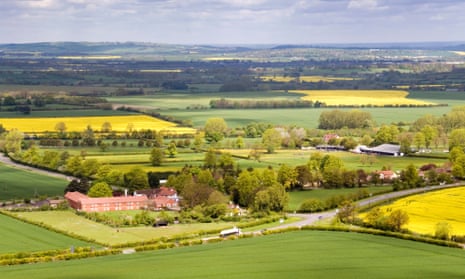
I’d seen it many times from the car – a huge chalkland escarpment through which the M40 sliced, but never considered it a place for exploration until lockdown forced me to look closer to home. I learned from the OS map that this was Aston Rowant nature reserve.
I started walking there in April as spring began to showcase the flowers of whitebeam trees, the distinct knocks of woodpeckers and bluebells lining the ground like an amethyst rag rug. By summer, the air was filled with chalkhill blue butterflies and the ground with trumpet-shaped purple Chiltern gentians. Autumn brought fungi, from the blackened King Alfred cakes clinging to felled trees, to spongy birch polypore – once used as a strop for finishing blades. Despite the reserve’s diminutive size, every visit was different and brought nature to me in macro. That’s why, this winter, even as motorists begin to fill the M40 once more, I still go back to Aston Rowant to watch the deer at dusk, see the red kites soar and find solace among yews coated in a thick layer of hoarfrost.
Phoebe Smith
Aberdeen’s free-spirited fishing quarter

I came upon Footdee on a crisp January morning. Filling a wedge of land between the sea and the harbour, this compact village has been subsumed into Aberdeen but retains a character so distinct it would not have surprised me had I been asked to show my passport. Pronounced “Fittie” (a corruption of Saint Fittick), the village was laid out in 1809 to rehome fishing families. The road-free community consists of pocket-sized squares formed by terraces of minute stone cottages.
Flamboyant “tarry sheds” – once used to store nets – add Jackson Pollock-like splashes of colour. It’s a conservation area now and the fisherfolk are gone, but Footdee isn’t preserved in aspic. Ordinary working people still live there, and the memory of its vibrant and free-spirited air has stayed with me.
Dixe Wills
The simple life, Powys
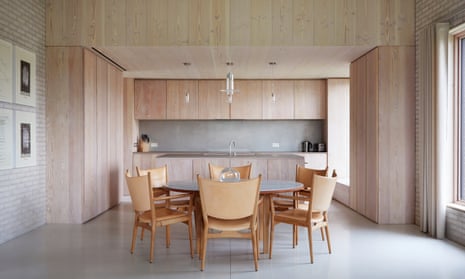
I’m a congenitally messy person, but a visit in August to the Life House, a starkly modernist place of pilgrimage for architecture nerds, awoke my inner Marie Kondo. Set in rolling hills, it was designed by architect John Pawson for Alain de Botton’s Living Architecture project, with an almost fanatical emphasis on simplicity. The result is gratifyingly relaxing, even with sideways rain hammering the picture windows as bizarrely multicoloured sheep graze in the fields beyond. Each of the three bedrooms is themed on a different therapeutic pastime: music, reading or soaking in a hot tub. Sitting in its contemplation chamber, I resolved to become tidier.
Down the road at Llanbister’s Lion Hotel, the verdict was more mixed. The words “industrial outbuilding” may even have been used. Janet and Ray Thomas, who run the Lion and serve amazingly authentic Gujarati curry (spices supplied by friends in Ahmedabad), also took grim pleasure in telling us our temporary home had been the location for new horror film You Should Have Left, starring Kevin Bacon. Streaming it will give us an unusual way of revisiting our holiday memories.
• living-architecture.co.uk
Marcel Theroux, author of The Secret Books
Rediscovering Richmond Park, London

Richmond Park isn’t just the best park in London, it’s one of its most wonderful places full stop. Almost four square miles of grass and woodland with more than 600 deer roaming free. Three things sometimes spoil this idyllic spot: traffic on the road that circles the park; weekend cyclists who use it as a racetrack; and the roar of jets descending to Heathrow. In lockdown 1, however, all three were stopped for a couple of months, and the park bloomed in a way I’ve never seen. There were more visitors than ever, but there was also collective joy at the lack of vehicles and noise. I saw kestrels nesting and accidentally startled a doe and her newborn … the mother saw me off with a withering glare.
We’ve been compelled to “find the profound in the local” this year. For me, it’s cycling the seven-mile lap of the park every lunchtime; I’ve watched the leaves turn gold and red, then the same russet as the bracken and deer. The first week I rode flat out against the clock, but soon stopped timing myself, and now invariably pull over to take in the wildlife.
November brought the rutting season and the thrilling rat-a-tat of antlers. And last week I witnessed something that made my heart sing. With no predators, the deer rarely move faster than a slow saunter. But last week two fawns burst out of trees about 50 metres away from me, gambolling, skipping and chasing each other. They ran parallel to and at the same speed as my bike, so I could follow them for a whole, precious minute. It felt like a scene from a documentary by David Attenborough – a local resident and patron of the park.
Gavin McOwan
A Cumbrian valley to ourselves
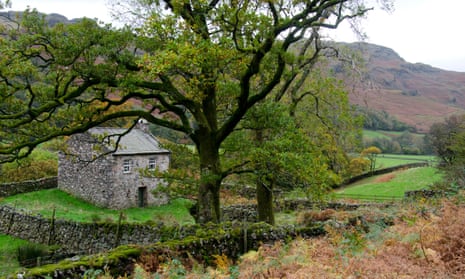
Photograph: Andrew Gregory/Alamy
Like fabric crumpled into ruffles and troughs, the Lake District always has some new crinkle to poke about in. I’ve been there most years since I was a child yet there’s still plenty of unfamiliar territory. This year I took my kids to Eskdale, where Bird How, one of the National Trust’s loveliest cottages, sits on a lonely lane. A cottage without a bathroom, mind, I told anyone envious of this last-minute bargain in that oversubscribed staycation summer.
The chemical loo didn’t add to the fun, but what did was showering outside: hooking up the hot, wobbly bag by the back door and washing mud off on to mossy flagstones while gazing at the purple flanks of mountains. There was a lot of mud. It rained almost constantly, and the river spread into the fields below, rinsing them a more vivid green.
The swimming “pots” of the Esk and ruined Hardknott Roman Fort were close by for kicks, and I went running up Harter Fell and into pretty Duddon valley. Squelching through knee-deep bogs, scrambling up brackeny steeps to windy clifftops, a bit lost and totally alone, felt freeing after 12 weeks of lockdown and home-schooling.
I cried while I ran too, thinking of my dad who had died six weeks earlier, and who had introduced me to magical corners of the Lakes on childhood holidays. The landscapes felt imbued with his spirit. I ran up the Old Man of Coniston in his honour – its summit the only place I saw crowds that whole July week – then drank the champagne he gave us last Christmas in the cottage garden, toasting the glorious valley we seemingly had to ourselves. We’ve booked again for next year.
• Bird How sleeps four, from £599 for seven nights, short breaks available in low season, nationaltrust.org.uk
Gemma Bowes
As good as Sancerre – and cheaper, Loire valley
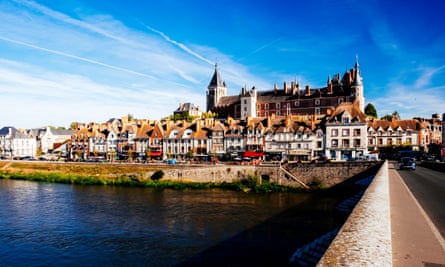
I have travelled around France to visit winemakers ever since I moved to Paris 30 years ago. But it was only this autumn that I discovered Coteaux du Giennois, 100 miles south of the capital. These vineyards lie on the banks of the Loire, between Gien and Briare, and normally I whisk straight past to the more-famous Sancerre. But a winemaker there suggested I stop at Domaine Poupat where, sitting in the cellar of genial, ruddy-faced Philippe Poupat, I learned that he grows the same grapes as they do in Sancerre – sauvignon blanc and pinot noir. The prices are a good deal lower than his famous neighbours’ and the quality is excellent.
The Poupat family have grown grapes since 1650, and monks began making wine here some 1,500 years ago. Monsieur Poupat does not just provide free tastings – he acts as an unofficial tourist office, with information on attractions from Gien’s celebrated porcelain to Gustave Eiffel’s epic Pont-Canal, a navigable aqueduct at Briare.
John Brunton
The pioneering aviator of the North Downs, Kent
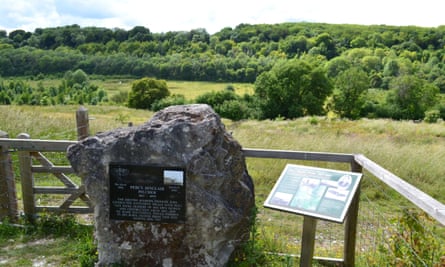
Walking in an obscure corner of the North Downs in Kent on a hot day, I saw a sign for the Percy Pilcher memorial. Thinking “sheep guru”, “medieval rebel” or “mediocre vaudeville entertainer”, we set off up an overgrown path after enlightenment, a view and a place to drink our ales. Serenaded by yellowhammers and skylarks, we arrived, sweating, at a gorgeous spot overlooking a valley.
What we then learned at the memorial stone surprised us. Pilcher was an 1890s pioneer of hang gliding and may have been on the verge of beating the Wright Brothers to powered flight when he died flying his Hawk glider in 1899. Many of his flights took off right here – though not his final one. It is also the site of the first recorded woman to fly an aircraft: Percy’s cousin Dorothy took the Hawk’s controls briefly before harmlessly colliding with a man operating a cinematograph camera.
This idyllic impressionist painting of a spot is reached by walking three miles from Eynsford or Shoreham stations then taking the path south from Austin Lodge (or north from Romney Street). Well worth a hike.
Adam McCulloch
The perfect ski hotel, Austria
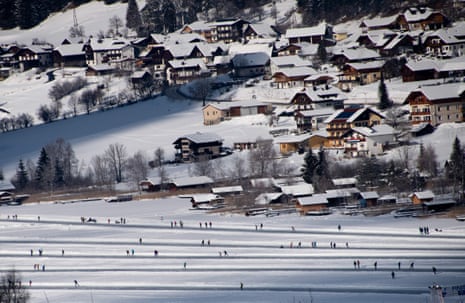
Carinthia is one of those regions that outsiders have been slow to discover. Italians love ice-skating on the Weissensee, which is the largest outdoor skating venue in Europe, but otherwise it ticks over on locals. For that reason it’s home to the kind of family-run ski hotel that is long gone elsewhere, the sort of place where they’ll sharpen your old kit in their workshop, dispense advice along with decent coffee, and lay on the kind of food you need after a day on the slopes. Hotel Alpengarten in Mallnitz is a friendly gem – literally: owners Peter and Michaela Angermann have a room full of geological specimens that Peter’s father found while exploring the nearby Hohe Tauern national park. Cross-country ski routes start 200 metres from the hotel and you can hire skis and snowshoes.
• Doubles from €148 B&B, alpengarten.at
Kevin Rushby
Cold cobbles and hot chocolate in Bratislava

There’s a chasm of books on the first floor of the Pálffy Palace branch of Bratislava’s City Gallery. Floor-to-ceiling mirrors create an illusion so compelling that walking through Matej Krén’s “Passage” feels lurchingly precarious, as the infinite reaches of human thought drop away below you into limitless space. The building itself, with its gothic vaults and baroque stairways, has a suitably eclectic history: displays include Celtic coins, modernist art and medieval Madonnas.
It took us a while to actually find the gallery as there is another Pálffy Palace nearby, where a six-year-old Mozart played in 1762. Bratislava’s old town was Christmas-card-pretty: the cobbles white with frost under old-style streetlamps. I was in Slovakia with my husband on what turned out to be our only trip abroad in 2020. January is the city’s coldest month, when temperatures rarely rise much above freezing, so we hopped between museums, beer halls and cafes serving thick hot chocolate and nutty rožok pastries. We rode the super-cheap trams (three days’ unlimited travel €8) and enjoyed the sauna in the basement of our hotel, the Skaritz (doubles from €79 B&B).
• gmb.sk, adult €4
Phoebe Taplin
A perfect pint in Berwick-upon-Tweed

Until 2020 I’d looked on the word “nice” with a superior sneer. Nobody, save possibly the sad and hopeless, wanted something nice, I thought. Then, at the end of the first lockdown, in a rush to go somewhere, anywhere, from which you couldn’t actually see my house, I found myself in Bridge Street, Berwick-upon-Tweed, sheltering from a buzz-saw North Sea wind that snarled along the walkways on the town’s fortified walls even though it was supposed to be high summer.
It’s a short, narrow street of tall buildings with a charmingly familiar yet unreal cosiness – Britain imagined by Studio Ghibli. An old-fashioned clock juts out over the stone pavement; there are shops selling old books, vintage toys and the sort of homewares you imagine Tove Jansson might have used. And there’s the Curfew micropub. It exudes the comforting cheeriness of a Sunday night TV series about vets. As I sat in the courtyard with a pint and a packet of crisps, for the first time in a while, life didn’t seem so bad. It was, indeed, nice, really nice.
Harry Pearson
Paddling Italy’s cleanest river
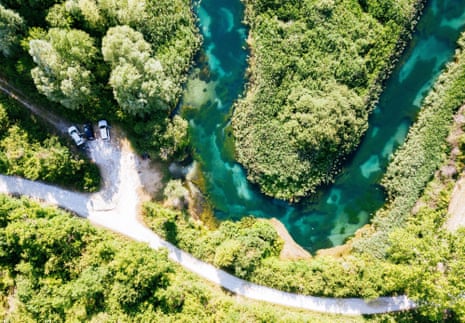
Many photographs of Italy’s Tirino river appear to have been enthusiastically retouched, but its blue, turquoise and emerald shades are for real. It’s the cleanest river in Italy – some say in Europe – and thanks to sunshine penetrating deep into the water, its bed is a tropical-looking riot of aquatic plants. We stopped off on our way down from the High Appenines in Abruzzo on a glorious between-lockdowns September trip. The Tirino rises in Campo Imperatore, the huge plateau 1,800 metres up in the Gran Sasso massif, but the first 15 miles of its course is underground; it pops up again in foothills near the village of Capestrano.
Turning off the SS153 at the sign for Camping San Martino, we met Piero from activity cooperative Il Bosso, which runs canoe trips (€30pp) up the Tirino to a lake so clear that it is, unusually for inland water, a magnet for scuba divers. At the lake, Piero encouraged us to swim – it was shockingly cold – drink the water and nibble shoots of water celery. Returning meant drifting with the current – no need to paddle – and Piero asked that we didn’t chat. So the final hour was spent in blissful silence, the wooded banks gliding by like a dream sequence. For hungry paddlers, the restaurant at Camping San Martino does great things with river fish – grilled trout, spaghetti with crayfish – and has a pool for a less bracing pre-dinner swim.
Liz Boulter
‘Seeing London through stained-glass eyes’
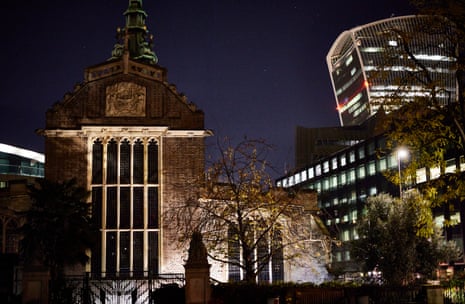
What is London? In big part it’s its river and churches. The Thames is the City’s soul, and the churches, for centuries, sought to save those of the citizens. More often now they salve souls, or so I have found, walking from steeple to steeple in this dark year. There are 48 churches in the Square Mile. On a plan provided by Friends of the City Churches, London appears very different from the gaudy planes of Google Maps. One experiences streets vertically: staring skywards, spirewards, but also down through time. That clock on the side of St Mary Woolnoth is the one TS Eliot wrote about in The Waste Land, striking nine with “a dead sound”. The oldest bell in St Clement Danes probably sounded its solemn notes on William Shakespeare’s ear. To see London through stained-glass eyes is to encounter a more beautiful, consoling City. I walked from St Magnus the Martyr to St Alban the Martyr, through lockdown and Ludgate Hill, longing for lighter days.
Peter Ross is author of A Tomb With A View (Headline, £20)





